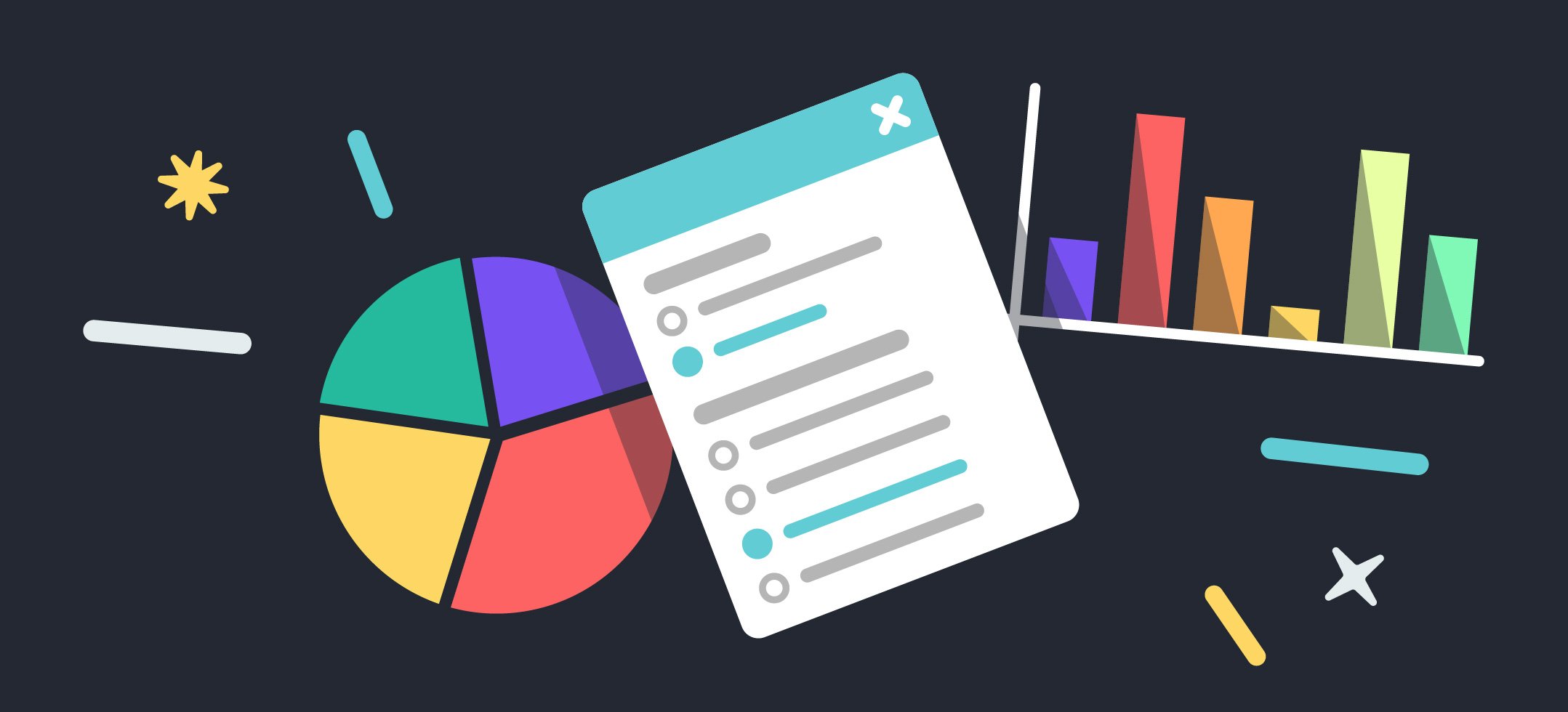
Ecommerce & Entrepreneurial Insights: Audience Survey Results for 2019
To help entrepreneurs stop questioning their own capabilities and to help them benchmark their journey amongst their peers, we send out a survey every year asking our audience about their business and their experience with entrepreneurship so far. It’s become a bit of a tradition.
By sharing these results, our aim is to demystify some of the assumptions people might have about entrepreneurship and to help budding and experienced entrepreneurs measure their progress against others who are building, launching, and growing their online businesses.
If you’re signed up to our email list, you probably saw us send out this year’s Ecommerce & Entrepreneurial Insights Audience Survey. If you were one of the hundreds of people who submitted your answers to the ecommerce survey, we thank you! It’s participation like yours that makes informative articles like this one possible.
We hope this article will show all entrepreneurs, or “wantrepreneurs,” out there that although the entrepreneurial journey can feel lonely, you are not, in fact, alone. There are other entrepreneurs out there who want to start but don’t know how, there are some who have started building a business but aren’t sure if they’re doing anything right, and there are also many who want to grow their business but aren’t sure what steps to take.
Whatever stage you’re at, you aren’t alone and this article can help you understand where your entrepreneurial journey stands amongst those of your peers and can help you manage your expectations as you start, launch or grow your business further.
So whether you want to start an online business but aren’t sure how or if you’re just ready to jump in headfirst and start something, the results of our survey will give you a glimpse into what others are doing and how they’re doing it so you can compare your progress and plan for your future.
Let’s jump into it.
Ecommerce & Entrepreneurial Insights: Audience Survey Results for 2019
Audience Information
First of all, here’s some information on our audience demographics so you have some context as to who these survey results are coming from.
AGE RANGE
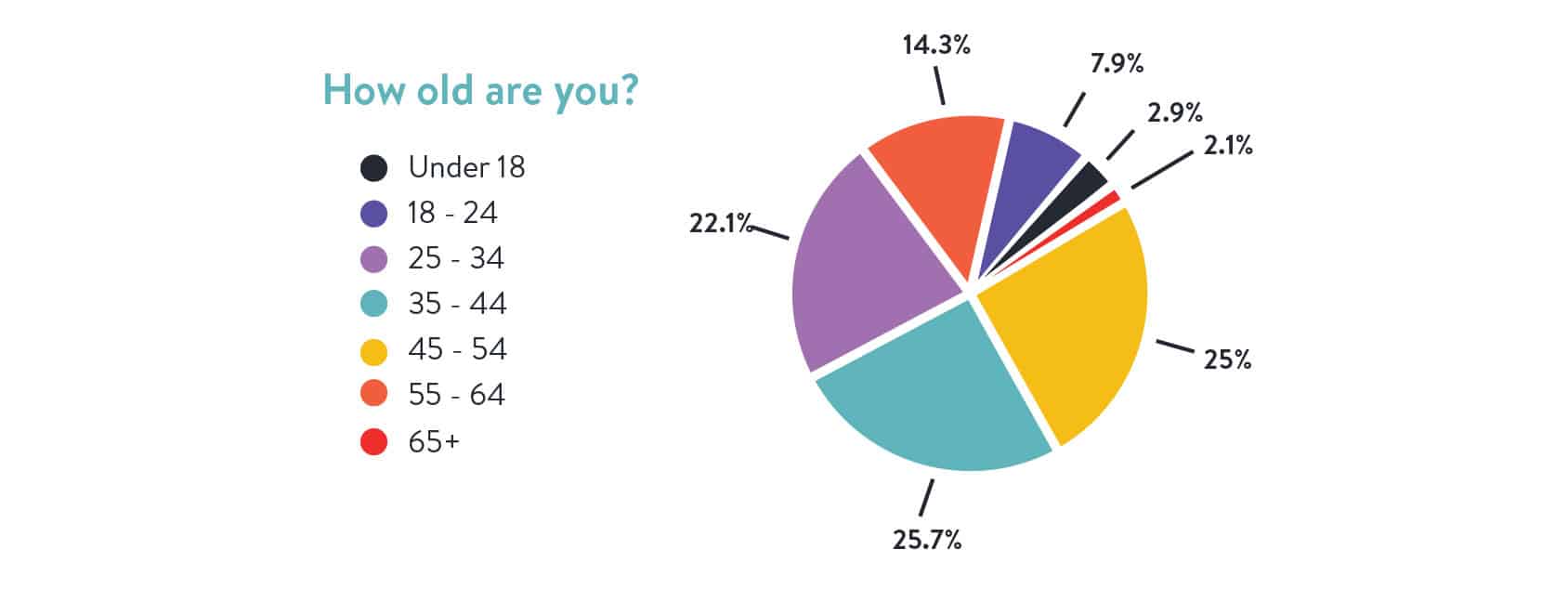
The majority of our audience is made up of adults in the 35-44 age range, which has evolved from our last survey because the majority of our audience then was in the 25-34 age range. Our next-largest audience age group is people aged 45-54 so that means that 50% of our audience is between the ages 35-55! Plus, a whopping 22% of people aged 25-34 consume our content, which means that 72% of our audience is between the ages of 25-55.
This is a large part of the working population so it makes sense that this age range of people is most interested in learning how to start a business or have already started their businesses.
Only 7.9% of our audience is made up of people aged 18-24, and an even smaller percentage of adults—2.1% to be exact—are 65+. These parts of the population are, in general, less likely to have the time, interest, or funding to invest in starting or growing an online business, so these results come as no surprise.
We’ve discussed previously why it’s so important for those who are part of the working population to strongly consider building their own businesses now, as jobs are evolving to become more automated and companies are moving to minimize their workforce in favor of cheaper, less volatile alternatives such as machines and artificial intelligence. It’s encouraging to see that the people who are likely to be the most affected by the reduction of human job positions in companies in the decades to come are also the ones who are taking action to build their own businesses—whether they’re full-time businesses or side hustles—so they can take charge of their future job security.
HAVE A BUSINESS VS. DON’T HAVE A BUSINESS YET
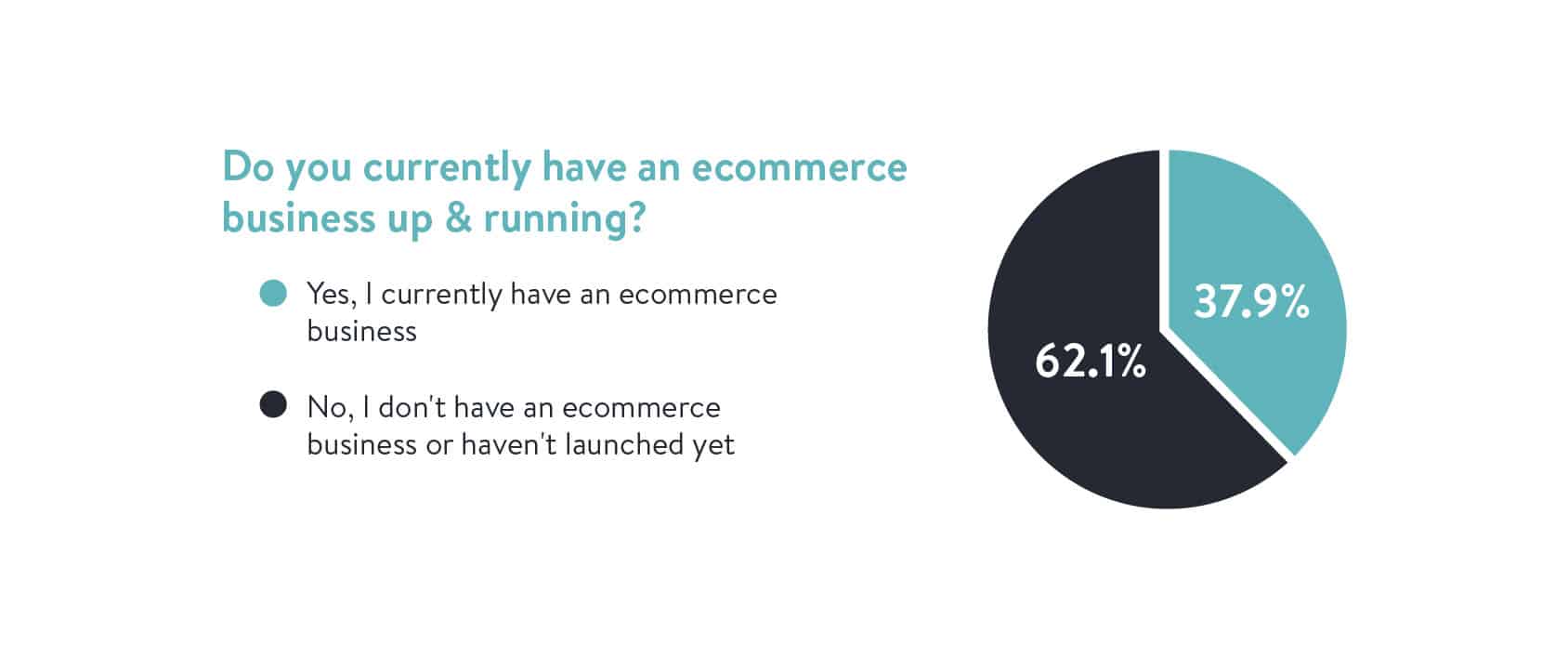
In similar fashion to last year, the majority of our audience is in the planning stages of building their online business, while a healthy percentage of our audience is already operating their businesses and selling to consumers at large.
This year, however, we have seen a slight increase in the number of people who have a business up and running! In last year’s survey, 34% of our audience had a business up and running and in this year’s survey, nearly 38% of respondents cited having an operating business, which is a win in our eyes!
Our aim here at A Better Lemonade Stand, as we discuss in further detail on our About Page, is to inspire, educate, and support entrepreneurs in the early stages of their entrepreneurial journey, so we’re happy to see the percentage of people who have a business rise as people who are currently in the planning stages of building their business eventually make their way into launching their business.
We also asked the entrepreneurs who already have an online business what their most important reason for starting an ecommerce business was, and this is what they said:
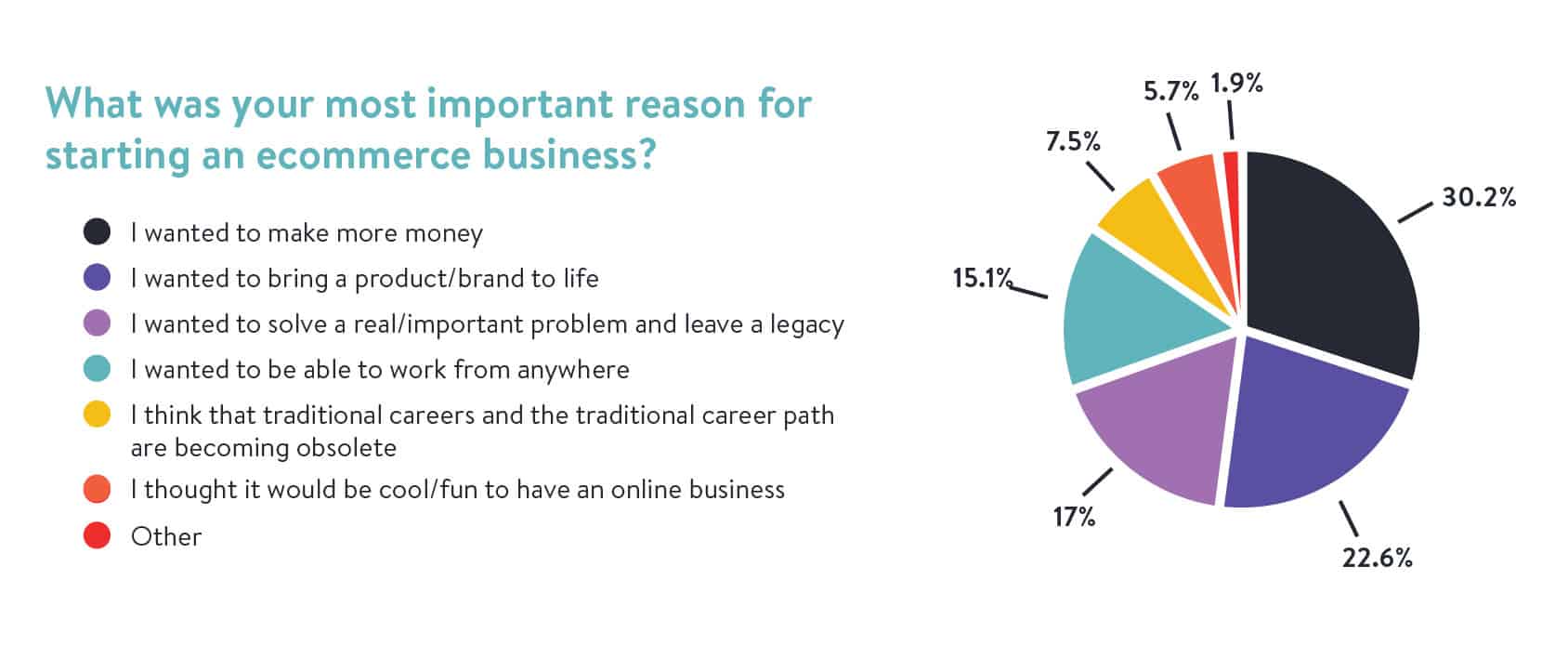
For the entrepreneurs who want to start an online business but haven’t yet, we asked them the same question. This was their response:
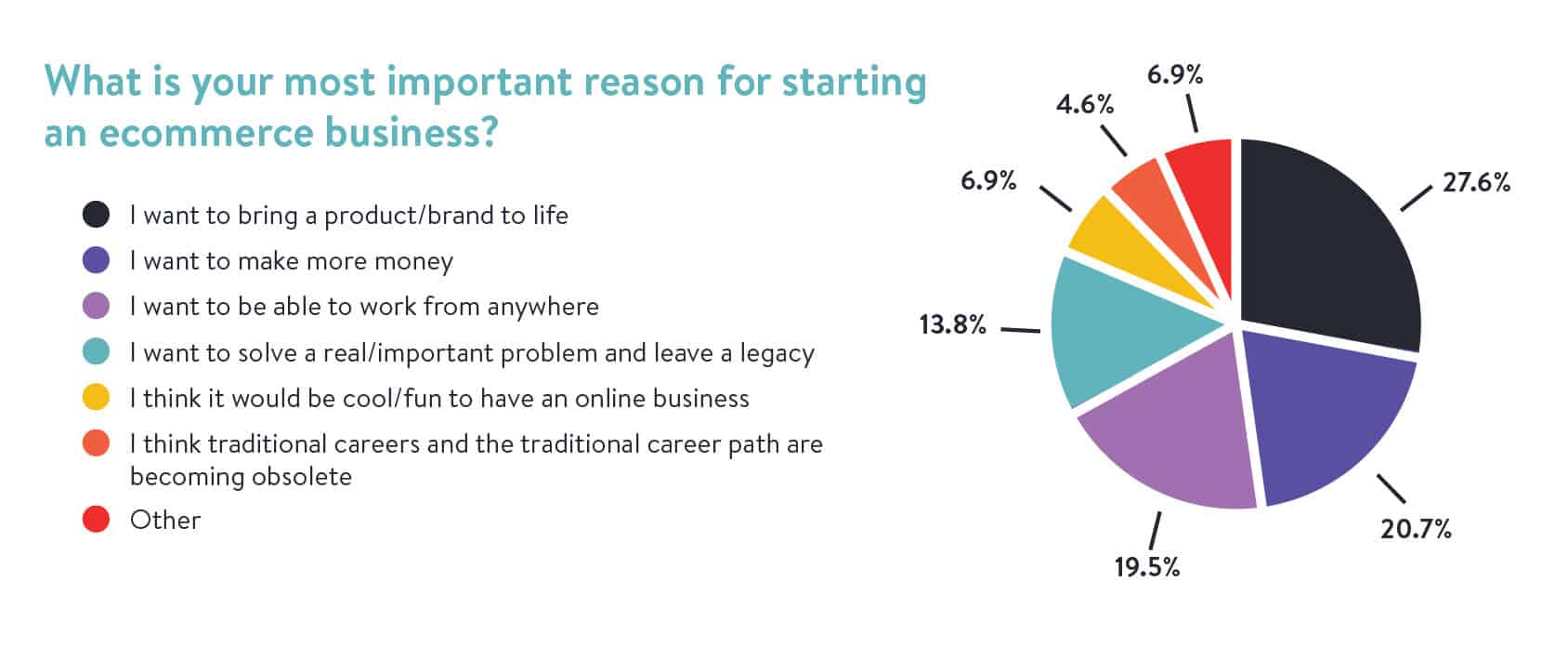
As you can see, the results between the entrepreneurs who have an online business versus those who don’t mirror one another. Their intentions for having started an online business versus wanting to start an online business are very similar and are likely very similar to many entrepreneurs out there who have already or want to start an online business.
For those who haven’t started an online business yet, we also asked them what’s holding them back from doing so. The results are pretty even across the board, with most people lacking or being intimidated by the monetary investment, others lacking the knowledge to invest in building an online business, and nearly just as many others lacking the time and product ideas to get started.
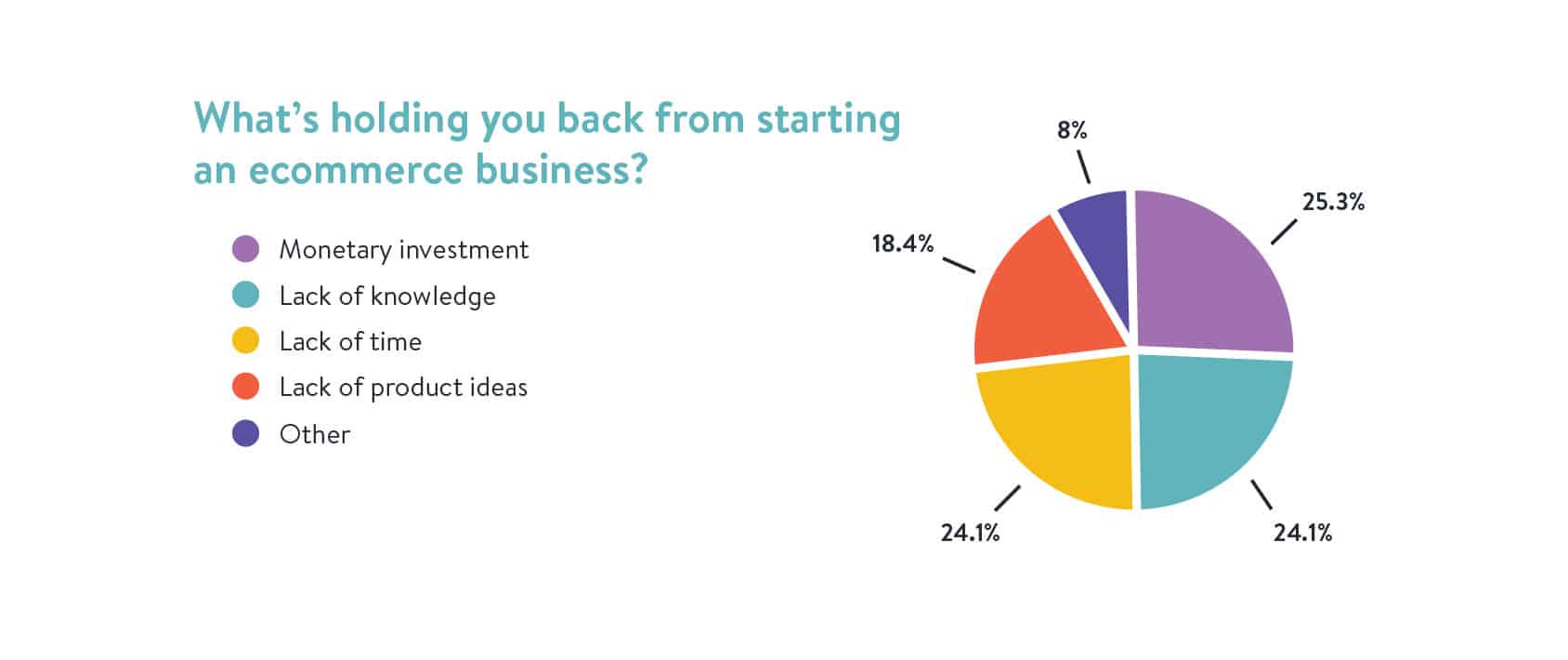
If you’re one of the people who fall into the lack of knowledge category, we encourage you to stick around our website and try out the various resources we have for people who want to start their own online businesses but aren’t sure how yet.
- Check out our ecommerce blog for informative advice, resources, and tips
- Download our START Guide to get a complete overview of the entrepreneurial process so you know what to expect
- Check out our One Page Ecommerce Business Plan for a comprehensive guide to building and launching your online business without missing a step
- Participate in our free video webinars to get starting building businesses from scratch
- Download our free guides & PDFs to find suppliers, niches and other important information to help you build and launch your online business
- Read the ecommerce business case studies to learn how others have built their businesses from scratch
- Subscribe to our weekly email newsletter to get new content & information sent straight to your inbox
- Use our Instant Product Evaluator Tool to get advice on your product ideas’ strengths and weaknesses
Beyond the resources we offer, there are other great places online that can help you learn more about ecommerce and starting your own online business. We recommend checking out:
- The Shopify Blog for articles covering everything you might need to know about starting your online business
- Skillshare for educational classes taught by leading professionals in many different industries. Find our roundup of the Best Skillshare Classes for Entrepreneurs here
- The Bench Accounting Syllabus for information and advice on bookkeeping and accounting for your online store
- The Indie Hackers website for support from all different kinds of founders creating profitable online businesses and side projects. The Indie Hackers Interviews section has lots of helpful case studies as well
- The Sumo Blog for comprehensive, in-depth and high-quality articles about entrepreneurship and business
- The Ahrefs Blog for information about SEO and marketing
PHYSICAL VS. DIGITAL PRODUCTS
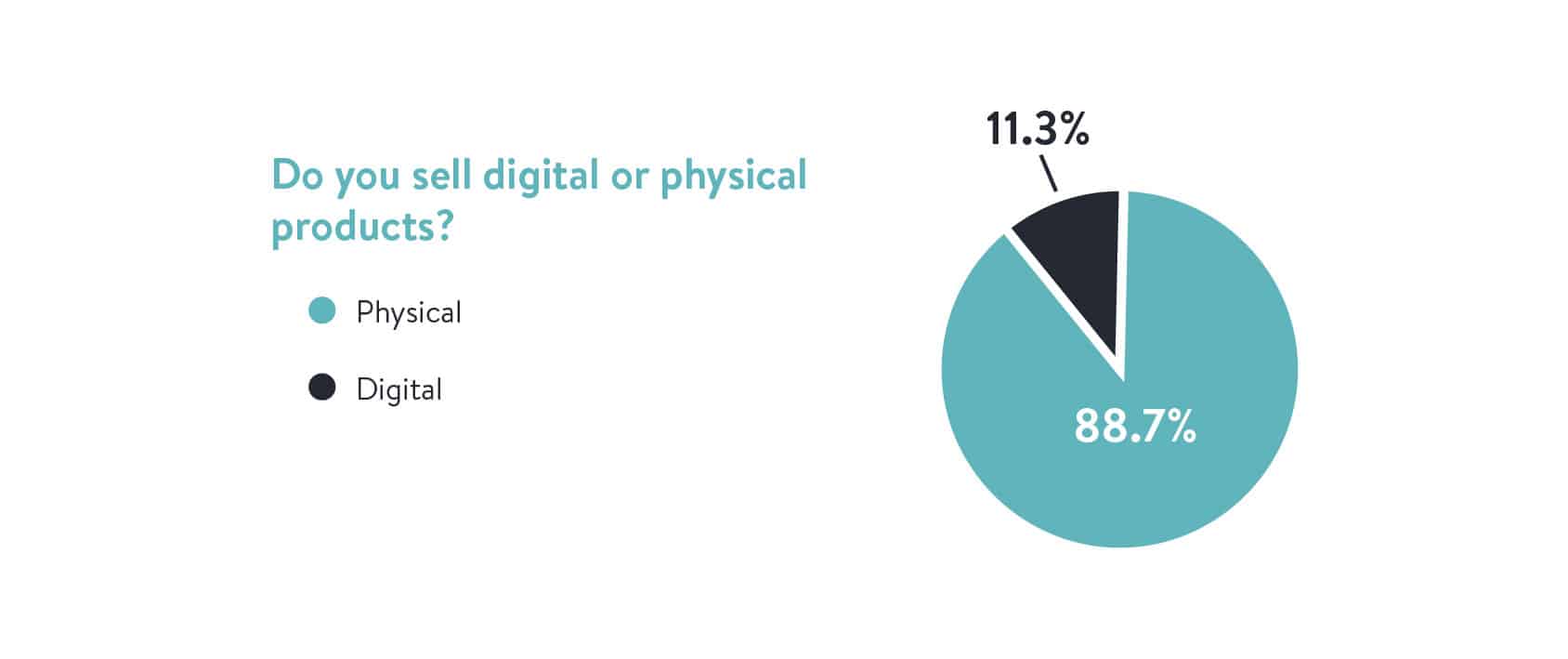
Out of the entrepreneurs in our audience who do currently have an online business, the vast majority of them sell physical products rather than digital products. This comes as no surprise to us as our content primarily focuses on helping entrepreneurs start ecommerce businesses that sell physical products, but we’re noticing a rising interest in people wanting to learn more about what kind of digital product options exist and how to get started selling digital products rather than physical products.
For example, even since our last survey, the amount of entrepreneurs selling digital products has almost doubled! In last year’s survey, only 6% of our audience responded saying they sell digital products but in this year’s survey, 11% of our audience sells digital products. That’s already a big jump in just one year, so we’re interested to see how the results to this question change in the coming years.
BUSINESS MODEL

The type of business model merchants use to sell their products is important to know because it dictates how so many other aspects of their business will operate, so we love observing the results of this question—especially as merchant sourcing method trends come and go.
A small majority of our audience dropships their products, and we see that this has grown slightly since last year when just 32% of our audience dropshipped their products. This comes as no surprise as it’s one of the most accessible ways to acquire products to sell online, and it’s one of the most efficient ways to start an online business, especially if a merchant is starting their very first online business.
The next most popular sourcing method is merchants who make their own products. This is a common sourcing method because the merchant has more control over their products and branding, but it can be difficult to scale your business if you’re solely in charge of making your products as it’s usually quite labor-intensive and takes a fair amount of time. So this is a great sourcing method if you’re running a side hustle or small business, but not so ideal if you’re looking to sell en masse.
A small amount of our audience also sources their products via manufacturing which again, makes sense. Manufacturing can be a difficult way to acquire products to sell online because there are often MOQs that need to be met, inventory that must be managed, and it’s just generally a much more expensive and time-consuming business model to get started with. It can be a very rewarding business model, though, because the margins are generally much more generous than any of the other business models, and it also typically allows for total brand and product control.
And finally, wholesaling is the business model that the fewest merchants in our audience use. This comes as no surprise because the dropshipping business model is similar, however, it’s usually much more easily accessible, less costly to get started with, and offers a little bit more brand control. Wholesale still requires some startup funding because there are usually MOQs to be met and when you sell wholesale products, you’re selling on behalf of another brand, which isn’t as on-trend in the entrepreneur ecosystem at the moment.
We also asked the part of our audience who don’t have a business up and running where they plan to source their products from. Here’s how they responded:
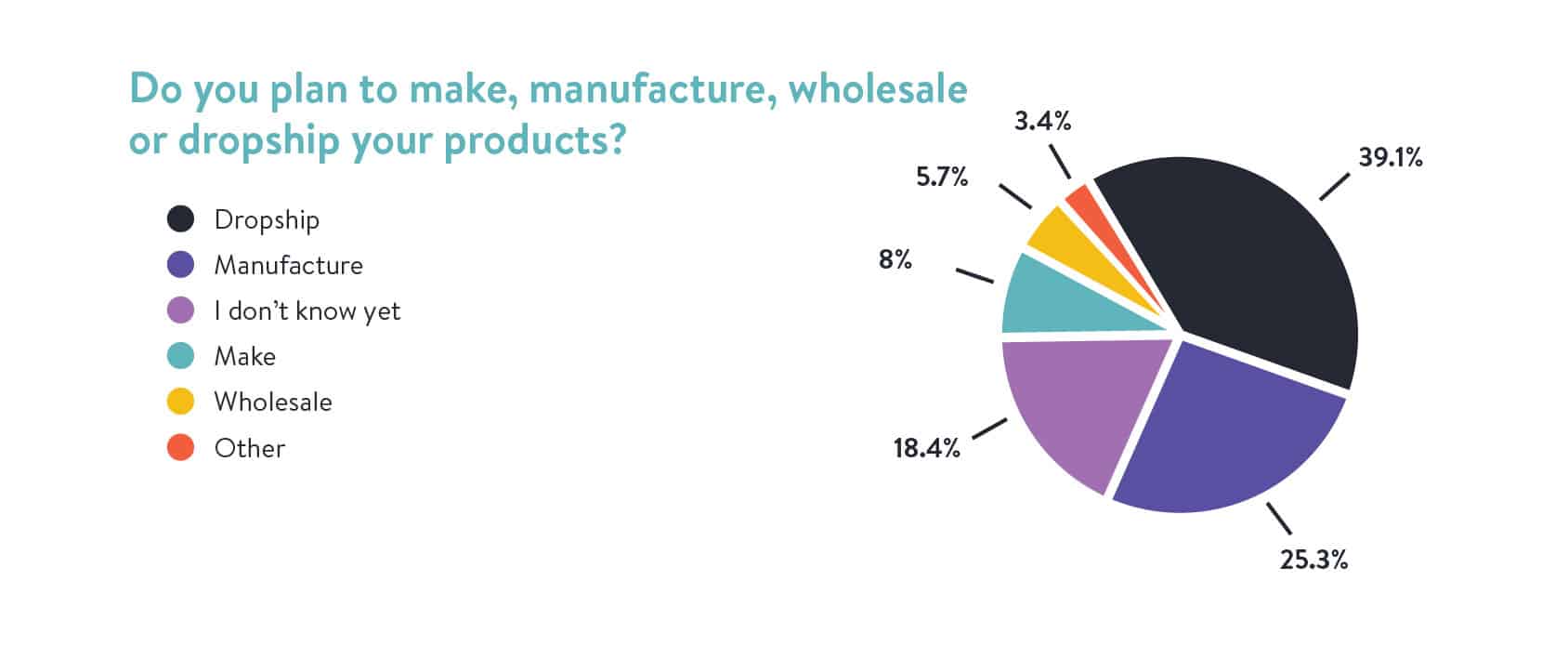
Much more of this part of our audience plans to manufacture their products, which we find interesting and in alignment with some of the responses in the Financing a Business section of this article. In that section, a significant part of this audience report that they plan to have a medium-to-large sized budget to finance the launch of their business, which would be necessary if they’re planning to manufacture their products because that usually requires much more upfront investment than any other product-sourcing method.
No matter which business model you choose, besides making products yourself, you’re going to have to find the right supplier for your business to source products from, so if you’re looking to get started sourcing your products via dropshipping, wholesaling or manufacturing, we recommend checking out our curated supplier directories:
- Drop Shipping Suppliers Directory
- Manufacturer Directory
- Clothing Manufacturer Directory
- Wholesale Suppliers Directory
- Private Label Manufacturers Directory
INDUSTRY
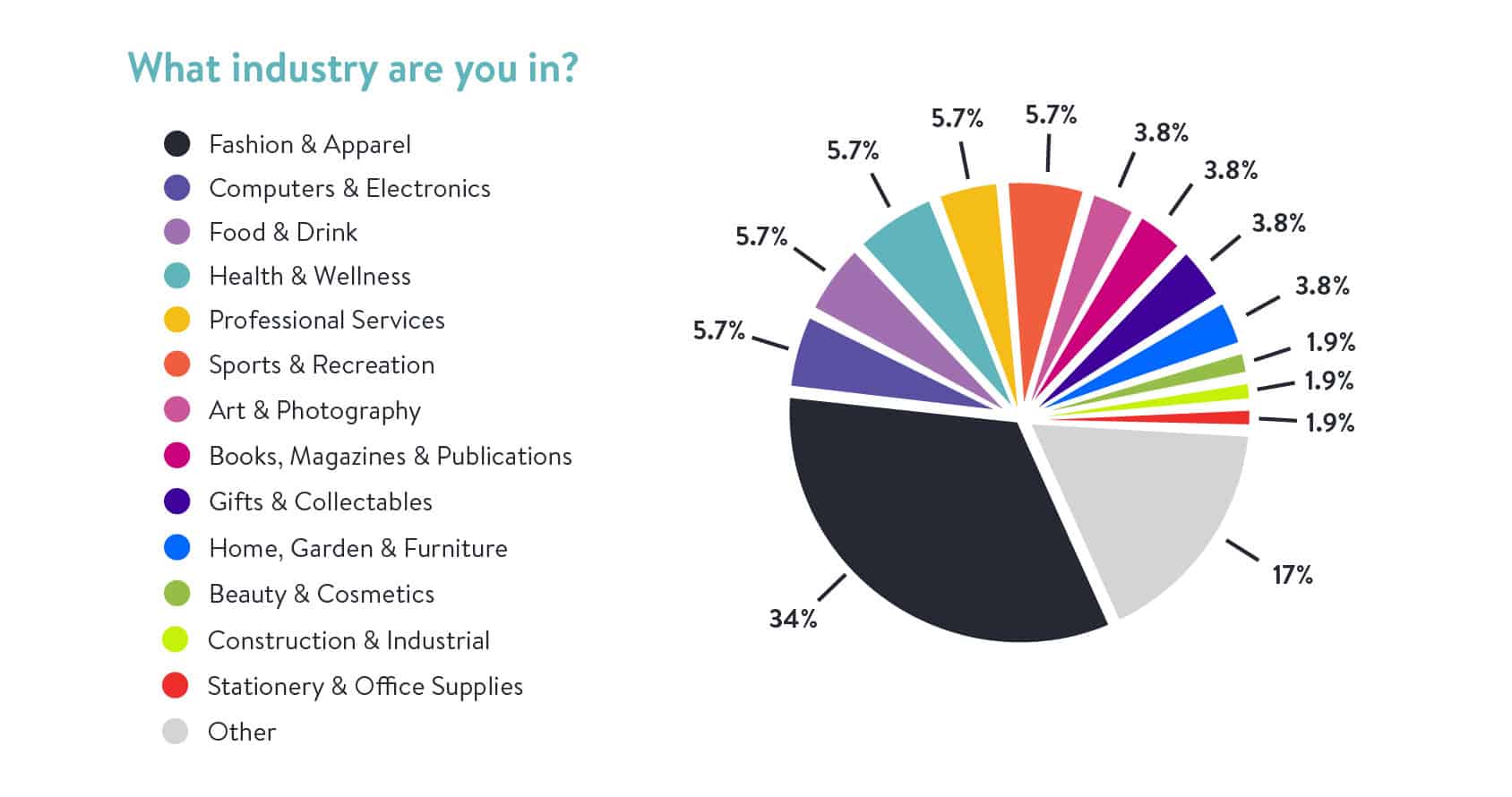
This is a great question you can use to get an overview of which industries other entrepreneurs currently sell in so you can understand what the most popular, and potentially profitable, niches are. Businesses don’t survive in niches that aren’t thriving, so the top niches on this list are likely to be the ones where consumers are most active and willing to purchase products.
If you’re looking to start your ecommerce business, consider which of these industries you’d be most likely to sell in and look to this list for a glimpse into the size of customer base you’d likely have and how many competitors you might be up against. The more popular it is, the more customers and competition you’ll probably have.
YEARS IN BUSINESS
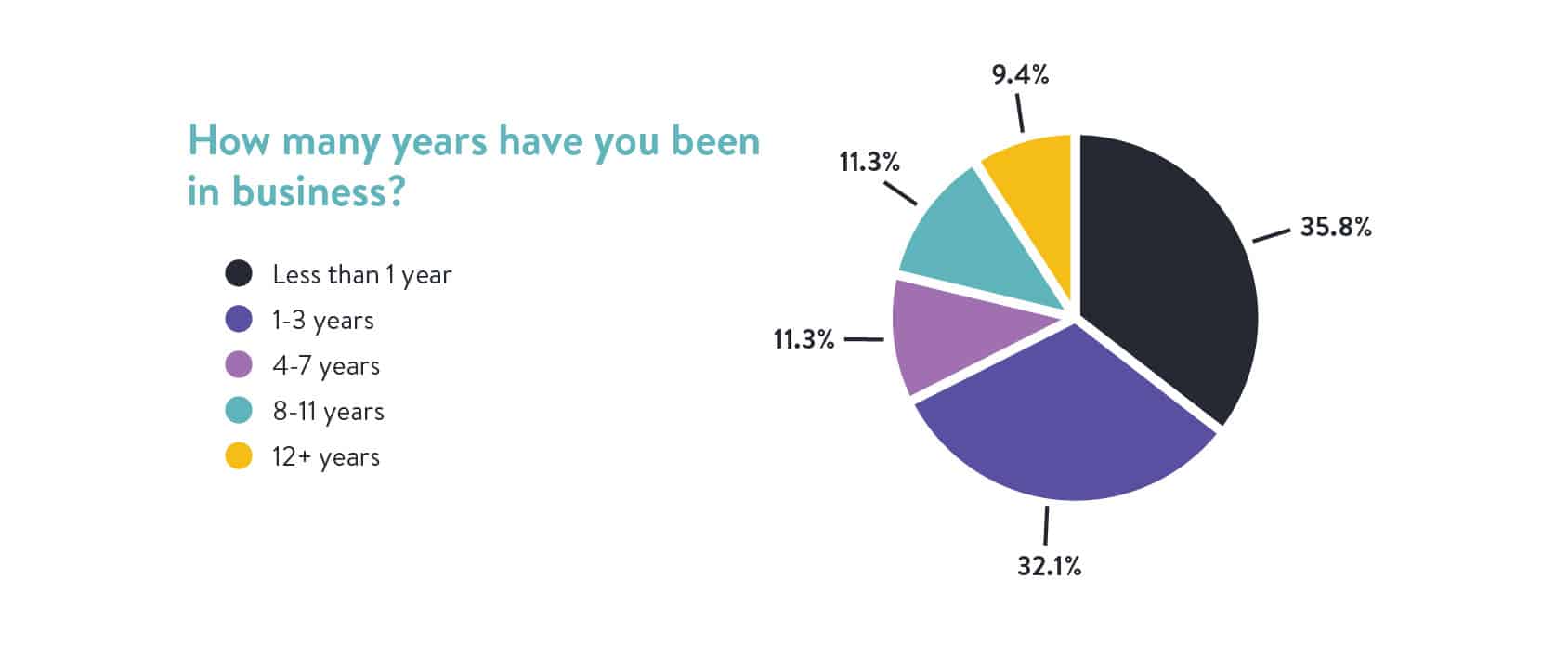
The vast majority of our audience who have online businesses are just in the beginning stages of operating them! Most entrepreneurs have only had their businesses for less than one year and almost just as many have had their business for 1-3 years.
Remember these numbers when we get to the final section of this article on Financing a Business. The numbers in that section primarily exist within the context of new businesses that have been active for 0-3 years, which is very important to keep in mind. Especially if you’re just starting your ecommerce business, those numbers can give you a good understanding of what the first 3 years operating your ecommerce business could look like.
Running a Business
Next, let’s dive into the data on what our audience is doing and using to run their ecommerce businesses.
For those who haven’t started an online business yet, this section can give you valuable insight into tools, tactics, and information you can use to build your future business more successfully, and for those who already have an online business up and running, this section can give you a glimpse into where you stand amongst your peers who also have online businesses on the go.
Let’s jump into it.
ECOMMERCE PLATFORM OR MARKETPLACE PROVIDER
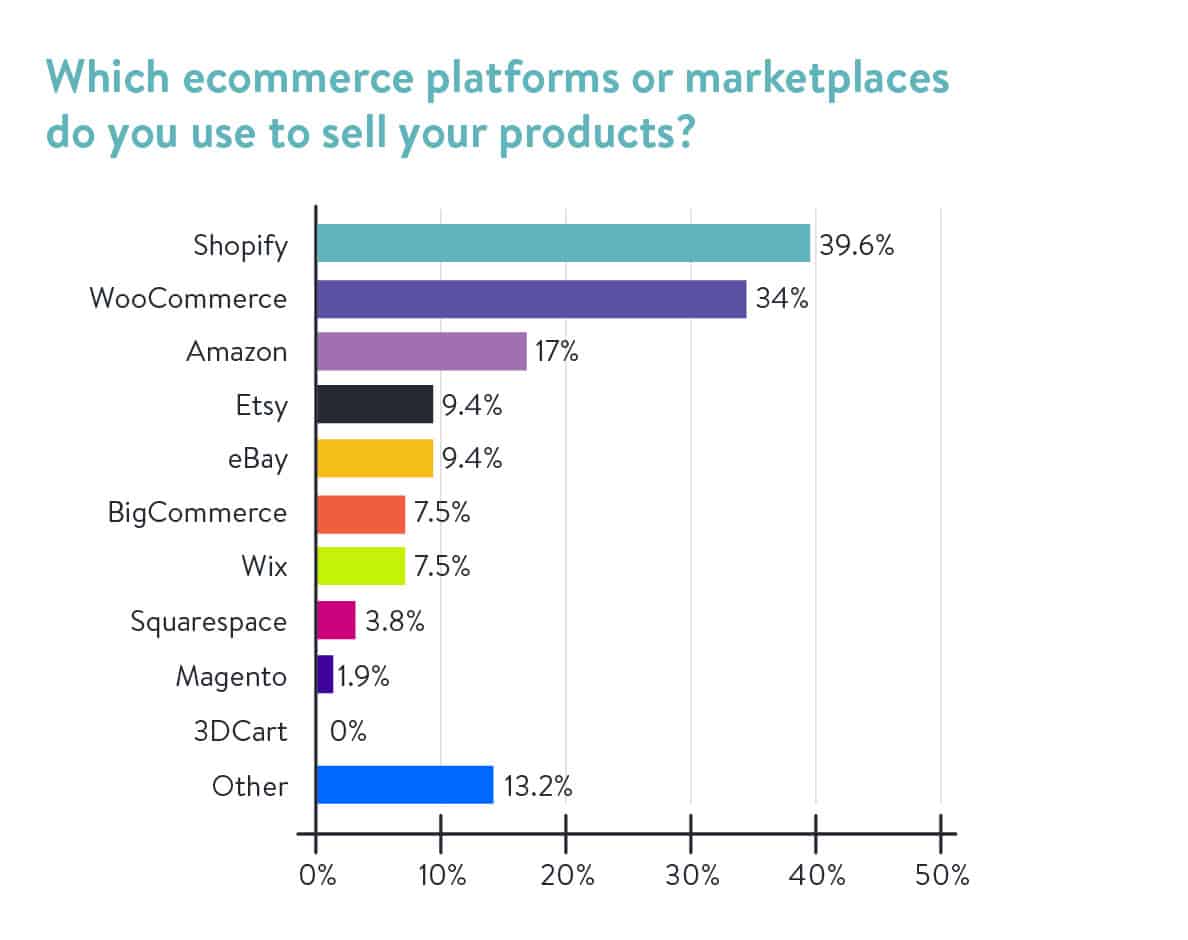
It comes as no surprise that the majority of our audience has built their online business on the Shopify ecommerce platform. Shopify is one of the top ecommerce platforms in the industry and is often the most highly recommended because it’s inexpensive to get started on and offers a host of useful features and reliable support.
When we conducted this ecommerce survey last year we noticed that a large part of our audience has built their online businesses not only on an ecommerce platform like Shopify but also on ecommerce marketplaces like Amazon eBay and Etsy. Online marketplaces can be a lucrative way for new businesses to launch into the ecommerce industry because there are already customers browsing and shopping on these marketplaces, which gives more exposure to brands listing products on the marketplace and makes it easier to get initial sales.
Plenty of ecommerce businesses have their own online store set up on ecommerce platforms like Shopify, BigCommerce or Magento and then also sell on marketplaces like Amazon, eBay, and Etsy. This way they can have the best of both worlds: They can own their own store on an ecommerce platform which means they don’t have to abide by marketplace rules but they can also benefit from the footfall that marketplaces attract to help their products be more discoverable and easily shoppable by consumers around the world.
BUILDING BUSINESSES AROUND A PASSION
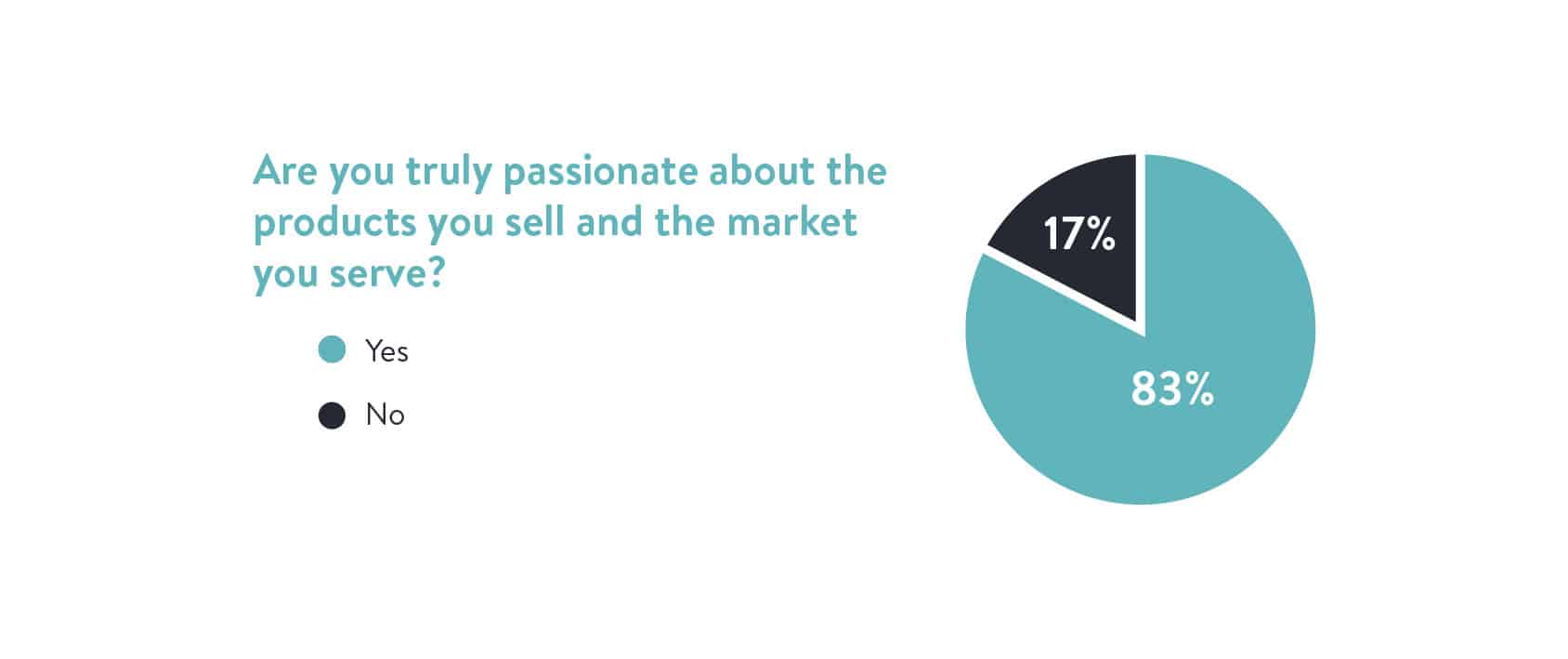
This is one of our favorite questions to ask entrepreneurs with ecommerce stores because we love seeing entrepreneurs passionate about the products they sell and the market they serve. We’ve discussed this on the blog before, but being an entrepreneur isn’t always easy and being passionate about what you do can really help see you through the challenging times.
It is by no means necessary to only start an online business because you’re passionate about the products you sell or the market you serve, however, it can be helpful in the long run to love what you sell and whom you sell it to.
Merchants who are passionate about their products are more likely to stick through the tough times that come with running an online business such as months of low traffic, minimal conversion rates, and high abandoned cart rates. It’s also useful to be passionate about the market you serve because you’ll be more in-tune with their wants and needs and will be more likely to create better products and shopping experiences that suit their interests.
It’s still very possible to create great products and a great shopping experience for your customers even if you aren’t passionate about your products or niche but it just might take more effort or research to achieve the same results as someone who’s passionate about the market.
SOLE FOUNDER VS. PARTNERSHIPS
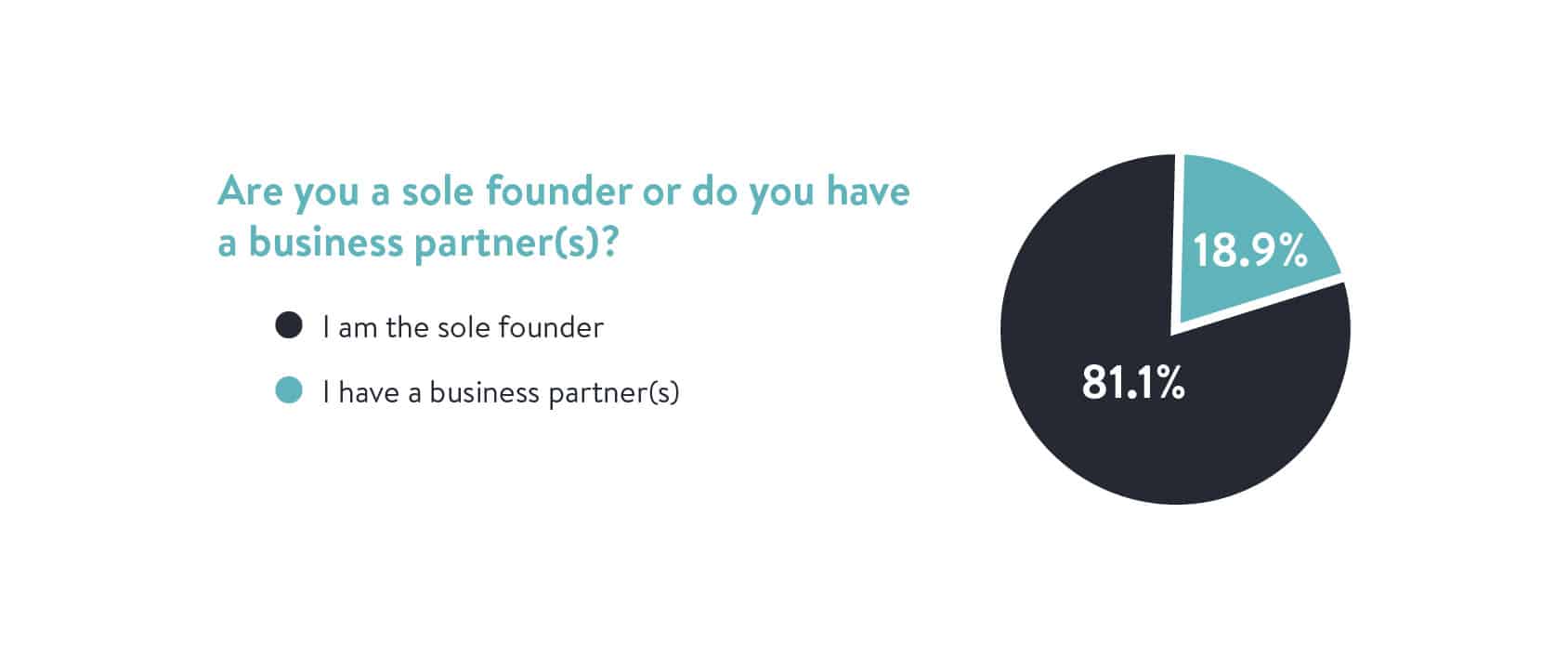
As you can see, the vast majority of our audience is made up of entrepreneurs who are the sole founders of their ecommerce business. For anyone who hasn’t started an online business yet, use this as inspiration to know that you, too, can start an ecommerce business on your own without the help or support of someone else.
Support and guidance from others can be helpful when it comes to starting and running an online business, but just know that it’s not necessary to get started.
Out of interest, we added another question this year that will hopefully be helpful for those of you who might be thinking about starting a business with business partners. Sometimes, working with a business partner can be an excellent experience—they might be able to run the aspects of the business you have no interest or skills in and they might really round-out your team and build the business to a place that you couldn’t have done on your own. However, not all business partnerships are like this.
Some business partnerships don’t work out and can leave you wishing you just did everything on your own in the first place. We caution you to really vet your business partners and take the results of the following survey question into consideration.
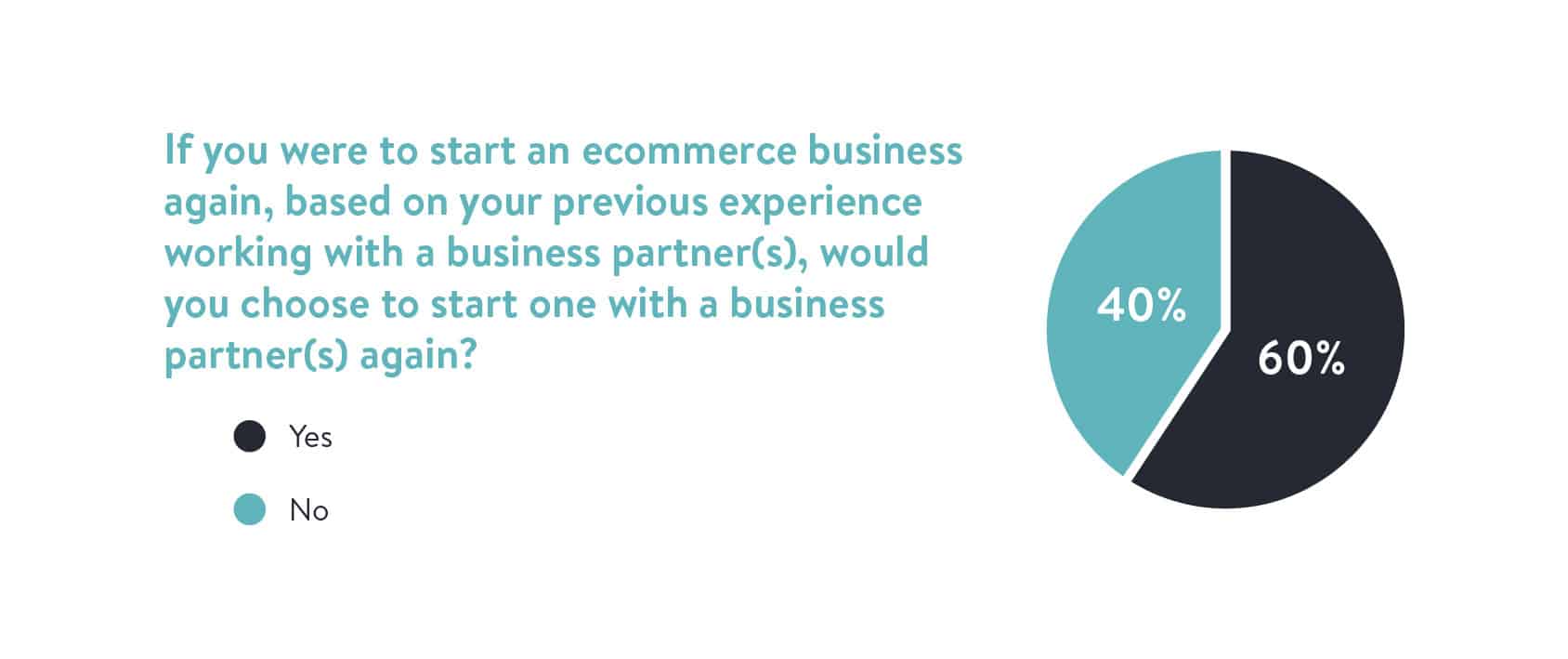
If our audience members who started an online business with business partners today were to do it over, 40% wouldn’t work with business partners again. That’s a pretty vast chunk, so maybe it’s something to think about.
BUILD A BUSINESS WHILE WORKING OR QUIT YOUR JOB
This is perhaps a question that every entrepreneur has asked themselves before starting their online business, and the truth is that it’s really up to each individual person’s unique circumstances and risk tolerance to decide which option is right for them.
This, however, is what our audience had to say about it:
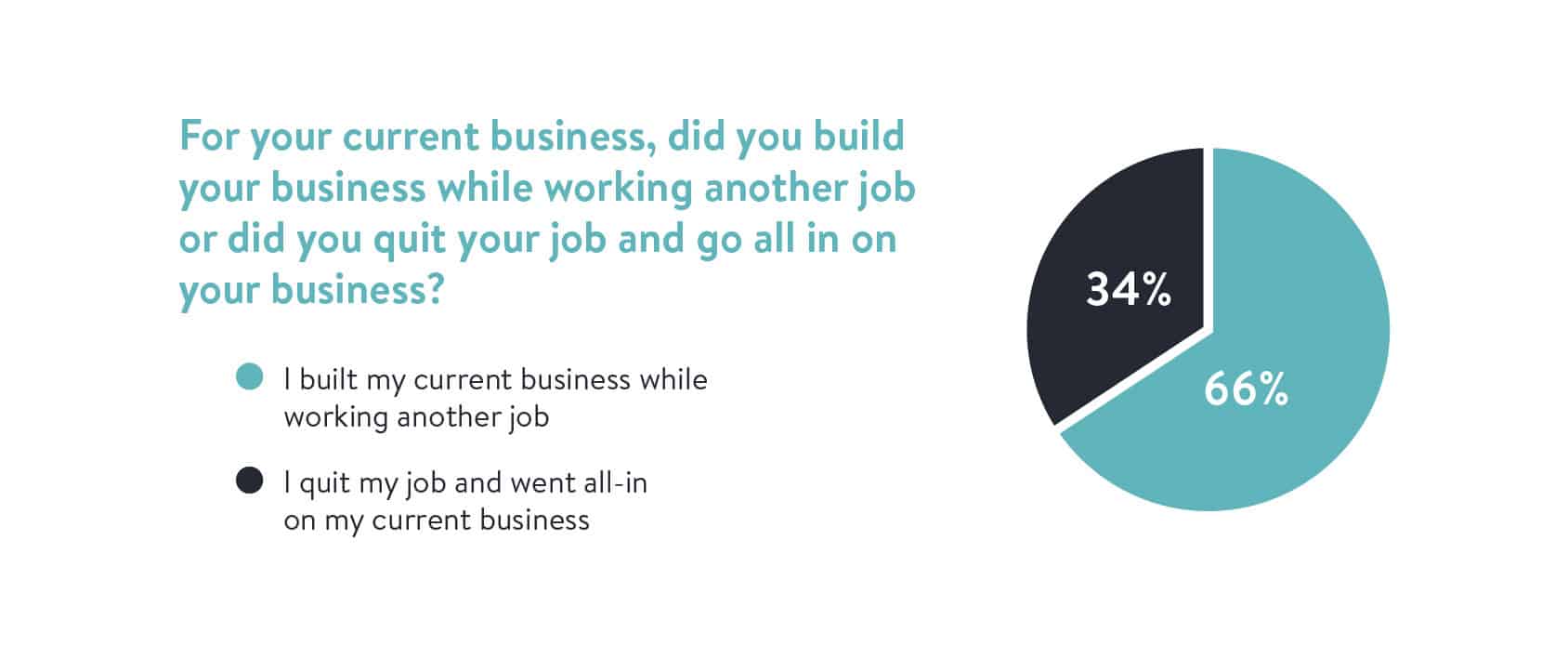
Since it typically does take some time to bring a business to life and generate a sufficient level of traffic and sales to make it a viable way to earn a living, it’s generally best to work on an ecommerce business as a side hustle first while working your regular job. This way, you are less likely to put yourself in a compromising position should your ecommerce business not work out or be as profitable initially as you may have expected.
Ecommerce businesses also require a fair bit of monetary investment, whether that’s because of the inventory required to stock the virtual shelves or to fund the ecommerce platform, apps, marketing channels, etc. required to get the business up and running, so it helps to have a reliable source of income that can help cover the initial startup costs.
Again, it’s totally up to each entrepreneur how they choose to approach this part of the startup process, but as you can see, the majority of our audience chose to start their ecommerce business while working their typical day job.
In last year’s survey, however, 29% of our audience quit their job to start their online business and in this year’s survey, we notice that number jumped to 34%! We find that quite interesting, and are intrigued to see how the responses to this question change in the future.
MOST EFFECTIVE SALES/ADVERTISING CHANNELS
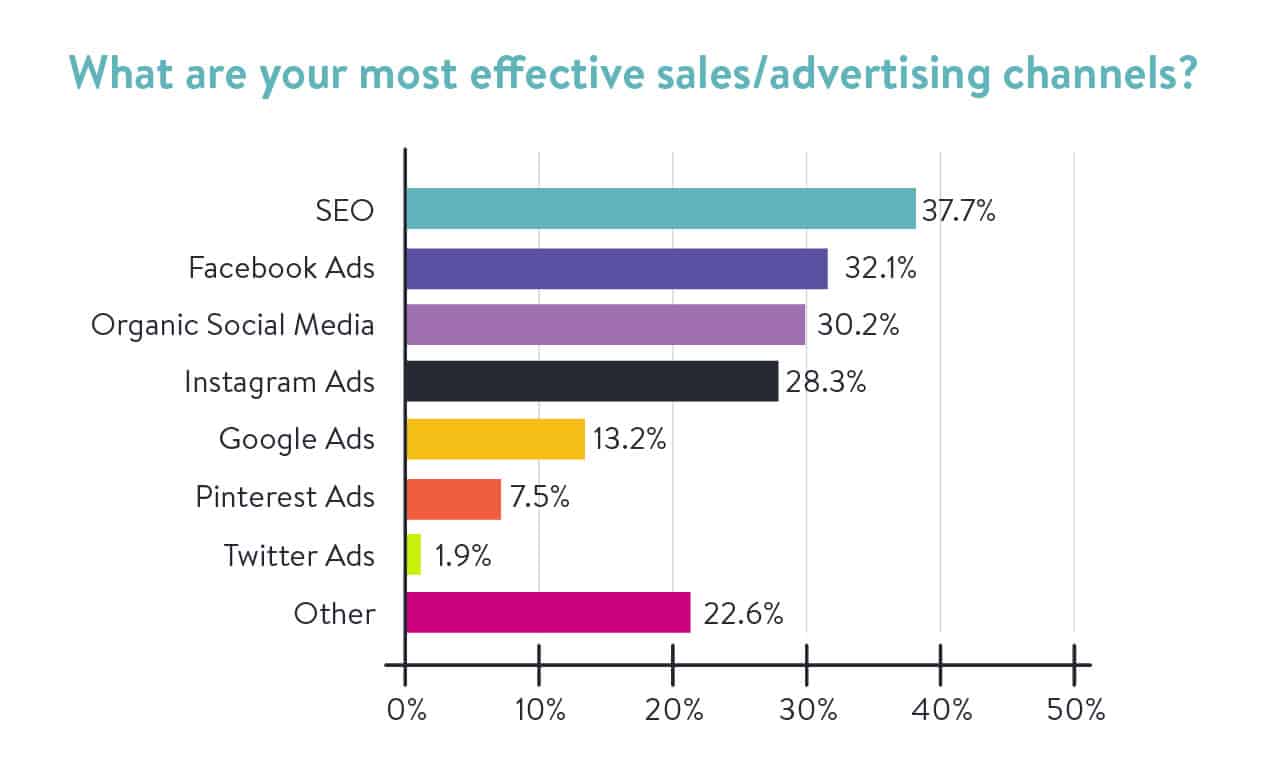
Interestingly enough, the majority of our audience uses SEO to attract visitors to their online store followed by Facebook Ads and organic social media. These results are comparable to last year’s so we’re not surprised.
We have noticed a decline in the number of merchants who use Facebook Ads to drive visitors to their store, however. In last year’s survey, 45% of respondents reported Facebook Ads as being their most effective sales/advertising channel whereas this year, only 32% said the same. That’s a 13% drop which is pretty significant and possibly something to take into consideration as for the future of Facebook marketing.
Since last year, the amount of our audience citing SEO to be an effective sales/advertising channel has grown by 7% and the effectiveness of Instagram Ads has also grown by the same amount.
ENTREPRENEURIAL STRUGGLES
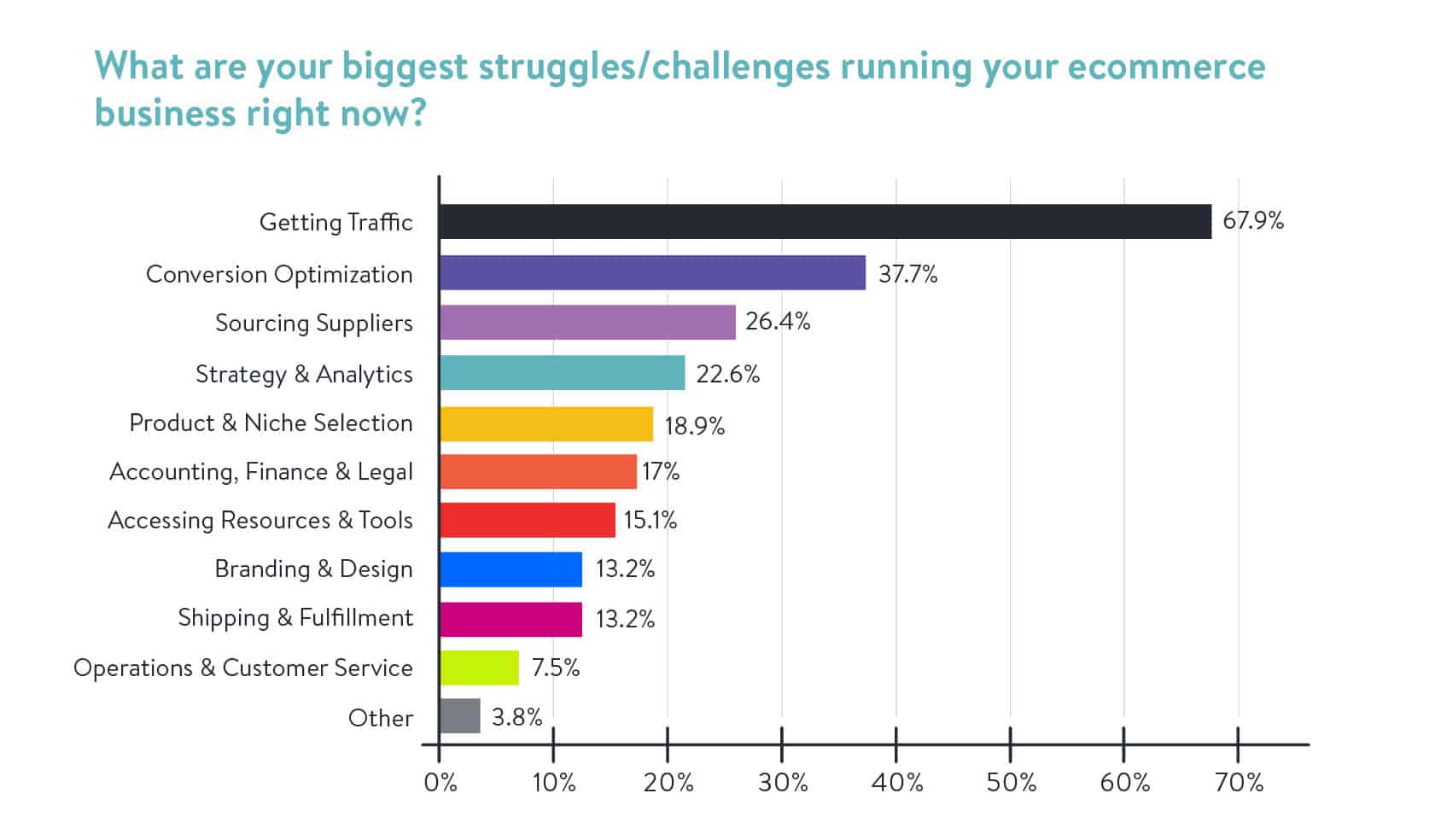
Typically product and niche selection is the area that we notice entrepreneurs struggle with the most, however, this doesn’t seem to be the case with merchants who already have a store up and running! A huge majority of our audience struggles to get traffic to their online store, and we don’t blame them. That can be one of the most challenging and time-consuming areas for entrepreneurs to deal with when starting and growing their online business, and it’s clearly one that many, many entrepreneurs are struggling with right now.
If this is something you’re struggling with, take comfort in the fact that you’re not alone. If it’s something you really want to work on, check out these resources to help you get started:
With this year’s survey results, we’ve noticed that difficulty surrounding Sourcing Suppliers seems to be on the rise. In last year’s results, 17% of our audience struggled with it, but this year, 26% are finding it difficult. That’s a huge jump so if it’s an area of business development that you’re running into roadblocks with, you might want to check out these resources:
- Sourcing Suppliers:
For the other problem areas, these resources can be great places to seek information from:
- Conversion Optimization:
- How to Get Your First 100 Sales
- Conversion Rate Optimization: Ways to Increase Sales
- The Complete Guide to Conversion Rate Optimization for First-Year Stores
- The Complete Guide to Reducing Cart Abandonment
- 6 Website Optimization Tactics: Neuroscience Principles to Increase Conversion Optimization
- Facebook Retargeting Ads: A Step-by-Step Guide to Sending Website Visitors on a Facebook Retargeting Journey
- Strategy & Analytics:
- Finding the Perfect Product:
- 500 Ecommerce Niches
- Reverse Engineering the Perfect Ecommerce Product
- How to Find a Product to Sell Online: The Definitive Guide
- 31 Ecommerce Products You Can Make Yourself
- How to Start an Online Business When You’re Not Ready to Start an Online Business
- How to Make Custom Phone Cases to Sell Online: The Complete Guide
- Accounting, Finance & Legal:
- Branding & Design:
- Shipping & Fulfillment:
- Accessing Resources & Tools:
- Operations & Customer Service:
FAILING AT BUILDING A BUSINESS
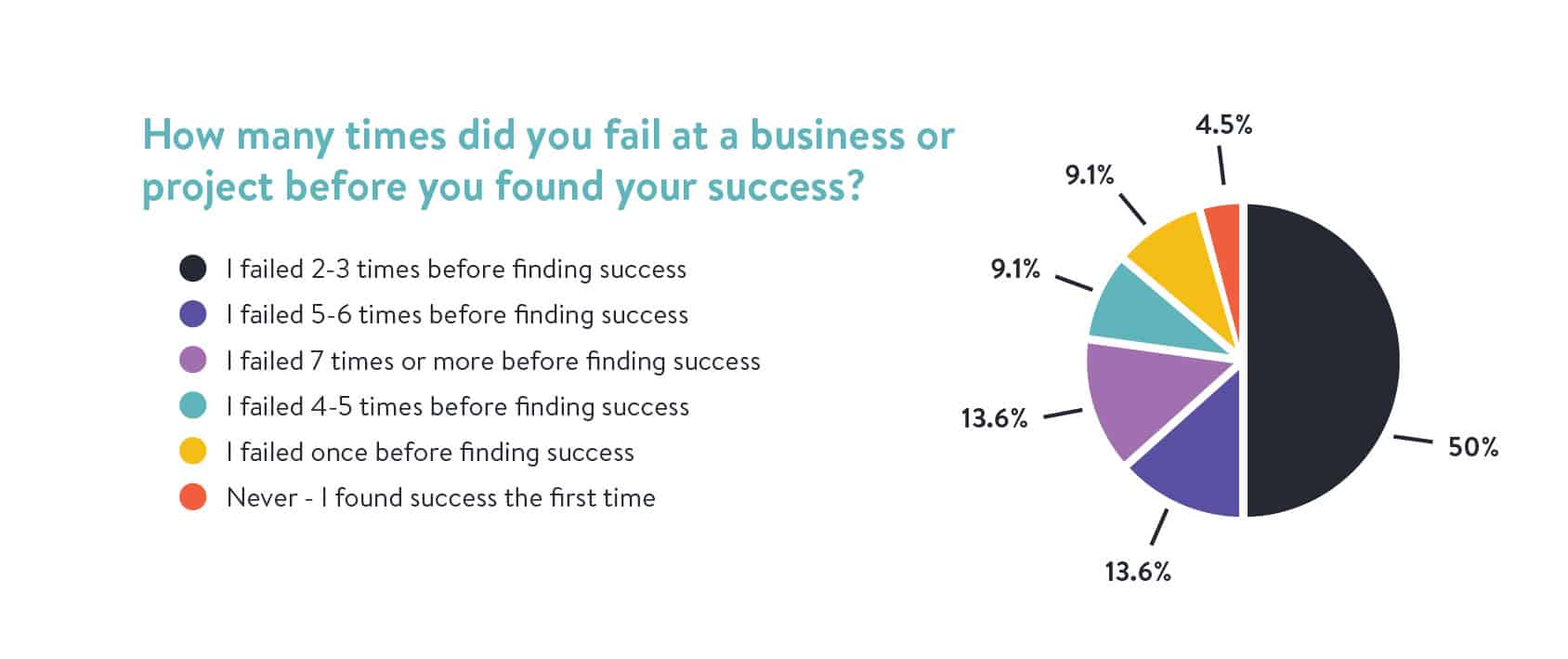
Look at these numbers: Over 95% of entrepreneurs failed at least once before they achieved their definition of success. 95%! That’s huge.
Out of that 95%, most of them considered to have failed 2-3 times before they achieved success and 13% failed at least 7 times or more.
This data just goes to show that trial and error is part of the entrepreneurial process and even if you’ve failed in the past when starting a business it doesn’t mean you can’t be successful in the future.
Of course, everyone’s definition of success is different and there’s no concrete way to define it, but take these results as reassurance that even if things don’t work out the first time, try again. The vast majority of entrepreneurs don’t create a successful business the first time, so don’t be too disheartened if you finding yourself starting and failing.
Financing a Business
The funds that it takes to start an online business can be a huge deterrent for new entrepreneurs wanting to build, launch, and grow their own online business so this section is particularly important as it gives a true representation of what our audience has spent in the past—and do currently spend—on their online business to get it running and keep it running.
If the monetary investment of starting an online business is holding you back, pay attention to the data in this section to see what funds you can likely expect to budget to start your online business. You might be surprised!
STARTUP & LAUNCH COSTS
First, we asked current entrepreneurs who have a business up and running what they initially spent to build and launch their online business.
There was quite a diverse range of responses, however, many people were able to build their business with $0-$250 in monetary investment! This goes to show that it’s possible to start an ecommerce business on a bootstrapped budget.
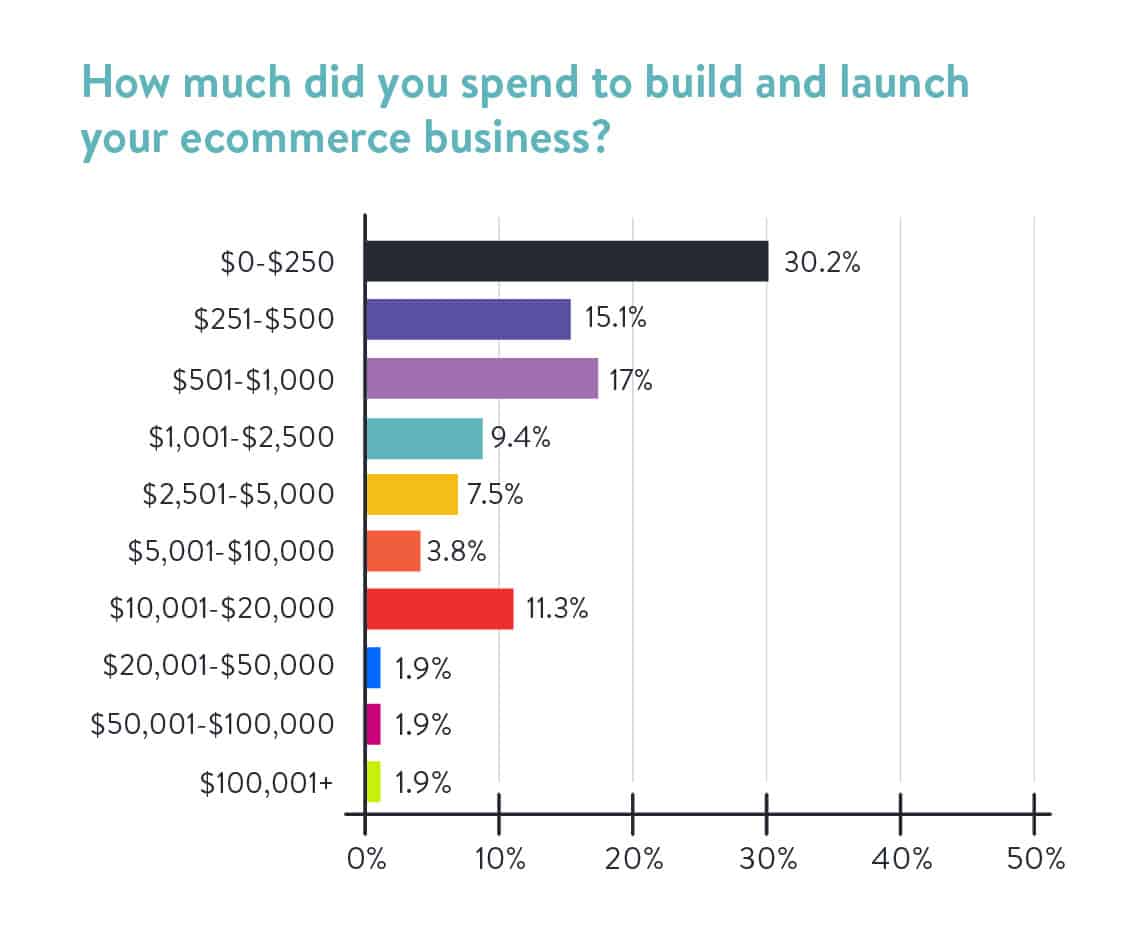
Next, we asked those who don’t already have an ecommerce business up and running what their budget is to build and launch their business when they do start it in the future. While the results were again, varied, many people reported setting aside a budget of $0-$250 or $2,501-$5,000 to spend on building their business.

Based on the results between the people who have started an online business versus those who haven’t, it seems that those who haven’t are planning to spend much more to start their business than those who already have. This discrepancy shows the illusion that an entrepreneur must invest a fair amount of funds into their business to build and launch it, when in reality that doesn’t seem to be the case.
There are many factors that can play into the startup costs of a business, including initial costs like inventory which can really eat into the overall budget, so an entrepreneur’s startup budget really depends on the business model they choose. Since a significant part of our audience operates under the dropshipping business model which requires less upfront investment initially because there’s no need to purchase inventory, it makes sense that many entrepreneurs in our audience started their business on a low budget.
BUSINESS’ MONTHLY REVENUE RANGE
Now compare this data with the previous section’s data: A significant portion of our audience started their business with a low budget, and a significant portion of our audience’s ecommerce stores are earning low levels of monthly revenue.
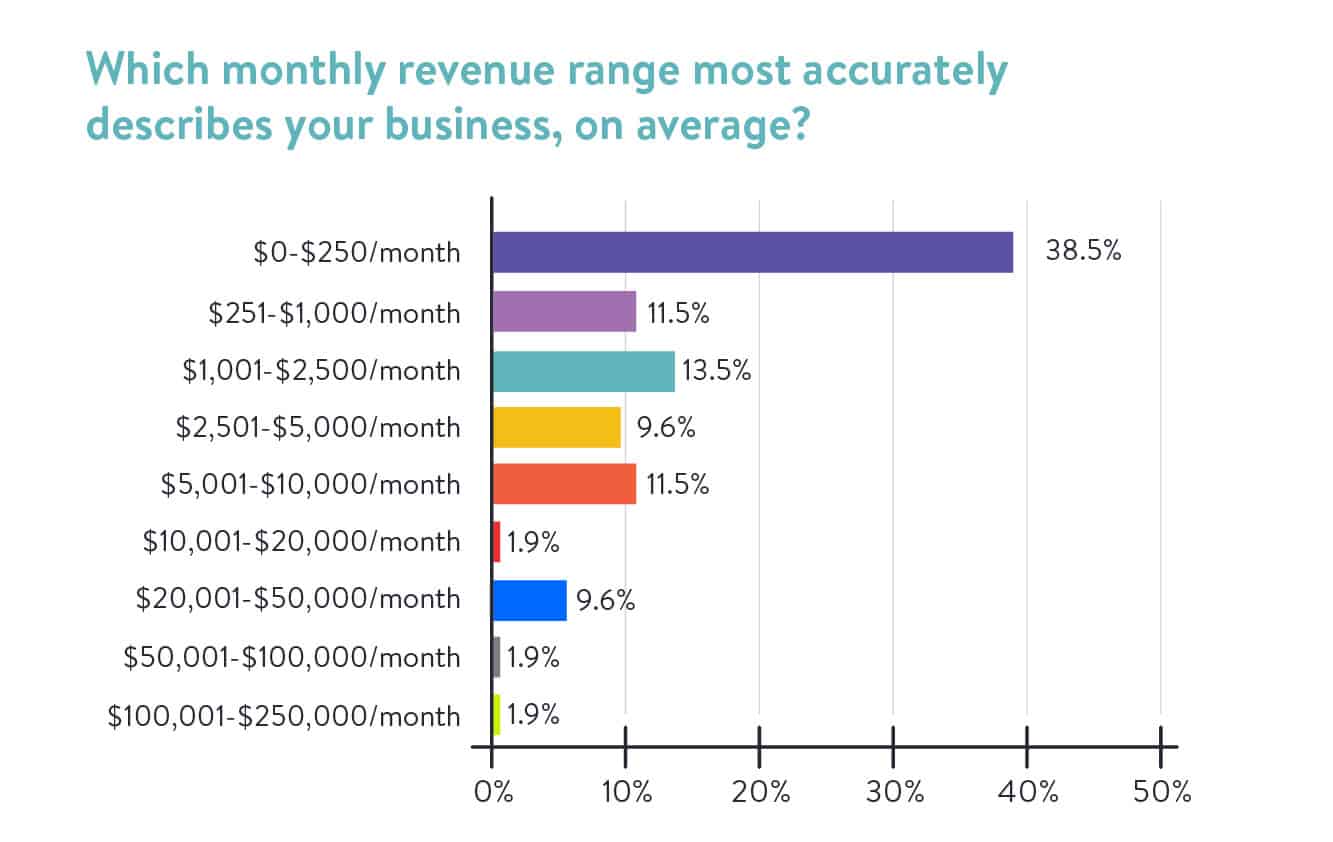
Take these points into consideration:
- A significant portion of our audience operates their businesses via the dropshipping business model which is well known, in general, for having low revenue earning potential and slim profit margins
- The majority of our audience’s businesses are between 0-3 years old, which means they’re relatively young and are still finding their feet within their industry and are building their reputation
- For our audience members who do have a business, they’ve reported that getting traffic and conversions are the two main struggles they deal with on an ongoing basis. This is likely to directly impact their sales and their monthly revenue range
For those who are looking to start an ecommerce business, this data can demonstrate to you what to expect over the few years after launching your online business. Take the above points into consideration and think about how you can combat the struggles other entrepreneurs are facing which potentially have a direct impact on their bottom line.
For those who do have an online business, use this data to see how you measure up amongst your peers! Think about where your monthly revenue range would place you in relation to others in our audience.
APPROXIMATE GROSS PROFIT MARGIN
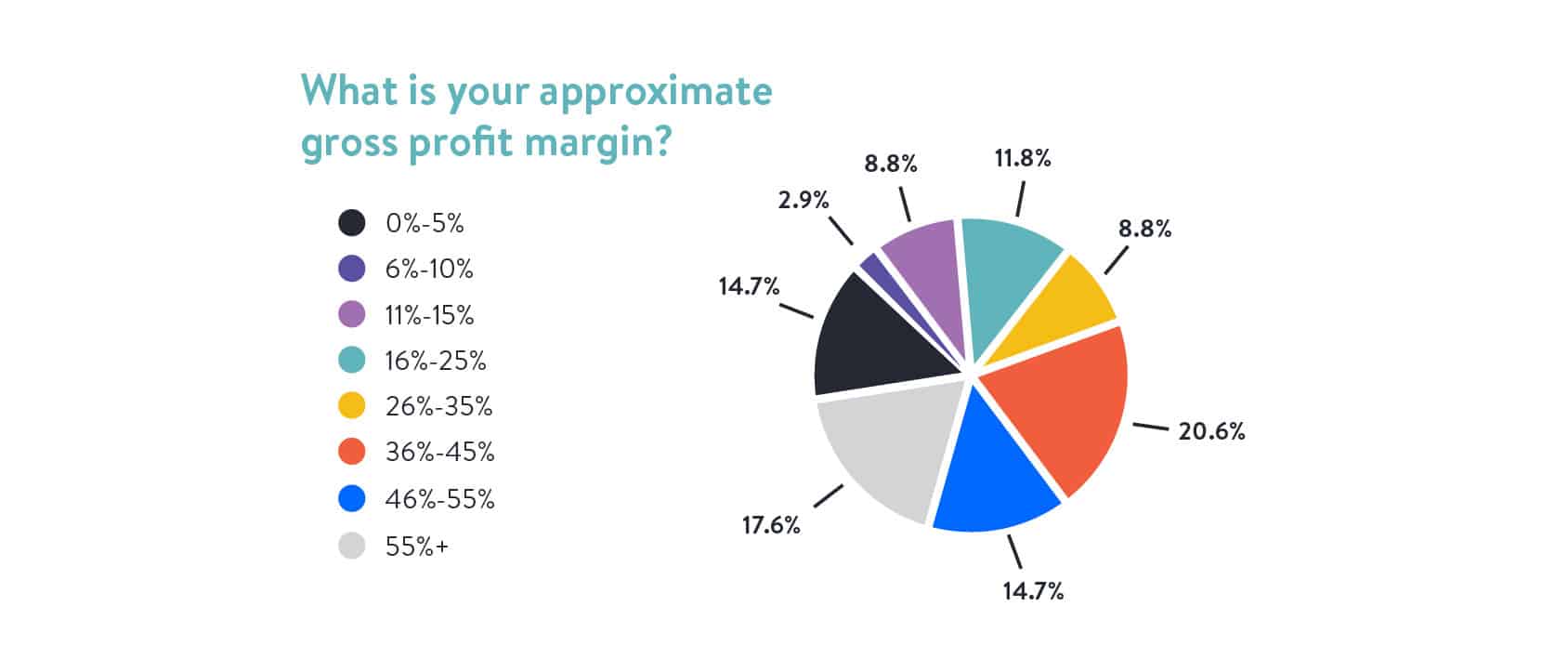
This year, we added a new question to get an idea of our audience’s gross profit margin, for the members who have online businesses up and running.
Considering that the vast majority of our audience reported that they source their products via dropshipping, seeing 36%-45% and 55%+ as the top two results is surprising. Dropshipping is notorious for having slim profit margins, so from these results, we’re guessing that our audience might primarily be working with high-quality dropshipping suppliers who compensate the merchants they work with in a fair way.
Regardless, it’s encouraging to see that our audience of entrepreneurs with businesses have such healthy profit margin percentages.
MONTHLY MARKETING & ADVERTISING COSTS
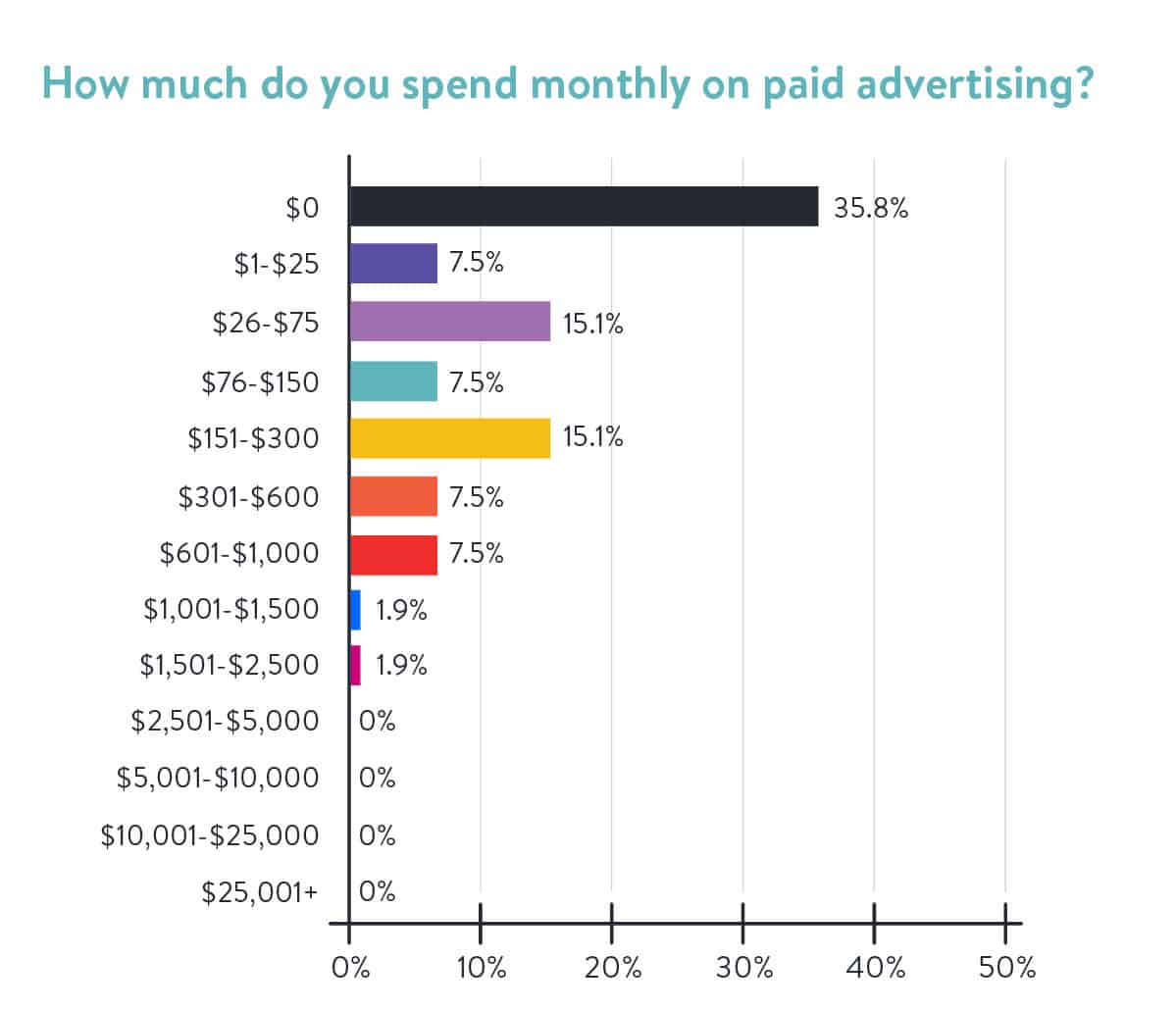
The results for this answer are fairly varied as well, but overall they show that ecommerce business owners in our audience don’t spend a large amount of their monthly budget on advertising their online business.
A large section of our audience, 35%, spends $0 on advertising, indicating that they likely rely on free advertising methods such as SEO and social media to get the word out about their business and products.
Here are some other findings we’ve noticed from the data:
- 15% of our audience spends between $151-$300 per month on advertising
- 15% of our audience spends between $26-$75 per month on advertising
- 7.5% of our audience spends between $1-$25 per month on advertising
- 7.5% of our audience spends between $301-$600 per month on advertising
This data shows us that the majority of our audience isn’t spending a huge amount of funds on advertising every month, but it seems like merchants are either spending virtually nothing on advertising or a few hundred dollars—there isn’t much in between.
MONTHLY APPS & SERVICES COST
Since a very small percentage of our audience spends $0 on apps and services every month to run their ecommerce business, the data from this question shows that apps are useful, helpful and worth the investment when it comes to running an online business.

Almost 86% of our audience spend at least some part of their monthly budget on apps for their online business, so clearly apps are necessary and essential for daily operation. The types of apps used for ecommerce businesses can vary from customer service support systems to recurring payments for subscription service business models to email marketing providers or even dropshipping suppliers.
There are so many different apps available for online businesses and especially for merchants selling on the Shopify platform—which is the majority of our audience—as it has the best and most diverse pick of apps on the market.
Interested in learning more about which apps you can use to help run your business? Check out these articles:
- 10 Essential Productivity Apps for Entrepreneurs & Business Owners
- 20 Smartphone Apps to Manage Your Online Business on the Go
- 10 Best Shopify Dropshipping Apps to Acquire Inventory for Your Business
Conclusion
Even though you might feel alone on your entrepreneurial journey, we hope that this article has shed some light on the struggles other entrepreneurs face and the choices they make to build, launch, and grow their online business. Use the data in this article as a jumping-off point to help you understand what it takes to start an online business if you haven’t already started one and if you have, use the results to measure your progress and benchmark your success.
There’s a lot to take away from the insights learned about our audience in this article, so we hope you can use it to build, launch, and grow a better ecommerce business.



